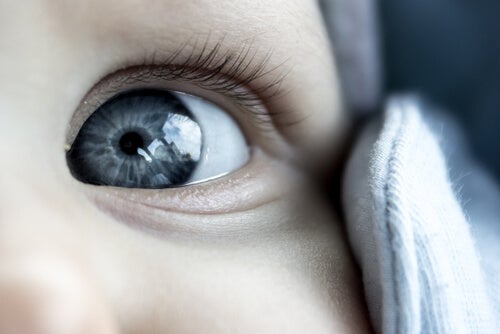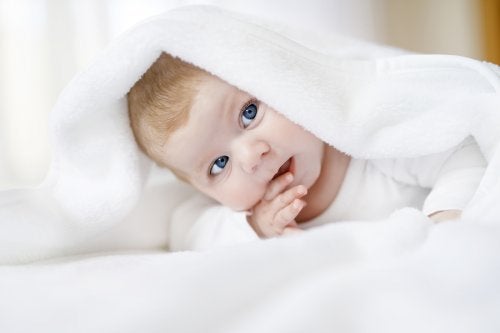How Babies See the World Around Them

After nine months of pregnancy, babies keep developing their vital organs and functions. This includes their eyes and vision. To know how babies see, you need to monitor the change of the central part of their retinas. In addition, you need to see their visual capacity grow in the first few months.
It’s common that, in the first few weeks of life, babies spend most of their time with their eyes closed. They do this after their eyes were very open when they were born. Human beings gradually start to incorporate two things from the moment they’re born: colors and focusing on things they see around them.
These two skills are ones that babies start developing from their first few days of life. When parents wonder how babies see, they should know that children are discovering shapes and colors, as well as close faces. However, they can’t distinguish between shapes and the background past 12 inches.
How babies see as they grow
As soon as they leave the womb, babies can see changes in light: clarity, darkness, and flashes more than anything. In fact, specialists believe they can also notice certain obvious contrasts. However, they still don’t know if babies see in color or black and white.
A clear sign that babies see changes between light and dark is that they’ll turn their head based on where the stimulus is coming from. In addition, they’ll also do that if the light is too intense.
Parents and doctors will notice that their pupils contract. This is because of their pupillary light reflex, which newborns have when they’re born.
When thinking about how babies see and the first things they discover, you can’t forget about their mother’s face. Babies will recognize their mother’s face, as well as their voice and touch. In fact, this is one of the first things that babies find or should find.

From two weeks on, what peaks kids’ interest are highly contrasting objects. Apparently, red is their favorite color at this stage. Also, they’re attracted to human faces, and especially peoples’ eyes.
Little by little, babies see farther than 12 inches. However, they’ll still have a hard time focusing with both eyes at once.
Around two months old, babies become very interested in the world around them. No wonder: here they have a 180º angle of view, and can follow slow-moving objects with their eyes.
It’s important to mention that all of this evolutionary process goes along with their growing head. Of course, this makes it easier to see more.
Contact with their environment
At 10 weeks, babies discover their hands, recognize their parents, and start to see details on things. Gradually, the stage starts where they start coordinating their hands and their eyes. They reach out to touch and grab what they want.
All of these skills keep developing in the next few months. When they’re four or six months old, babies see colors very clearly.
When they’re six years old, babies already discover nuances within the same color, and show it by taking an object of one color and putting it next to an object of the same color. At seven months old, they have a fixed gaze, and you can see them staring intently at objects.
Depth perception and the ability to follow faster objects also gradually develop. Around one year old, their vision develops significantly.

“As soon as they leave the womb, babies can see changes in light: clarity, darkness, and flashes more than anything.”
An app to know how babies see
Of course, there are anxious mothers and fathers who want more than these explanations. For them, Chicco launched Color Research, an application that simulates the world through the eyes of a baby.
This “game” consists of a magnifying glass that you move around the screen to see what babies see. In turn, the app has options for each developmental stage.
Although it might not be entirely accurate, it’s still very interesting, especially for those who are in contact with babies or take care of them.
This text is provided for informational purposes only and does not replace consultation with a professional. If in doubt, consult your specialist.
